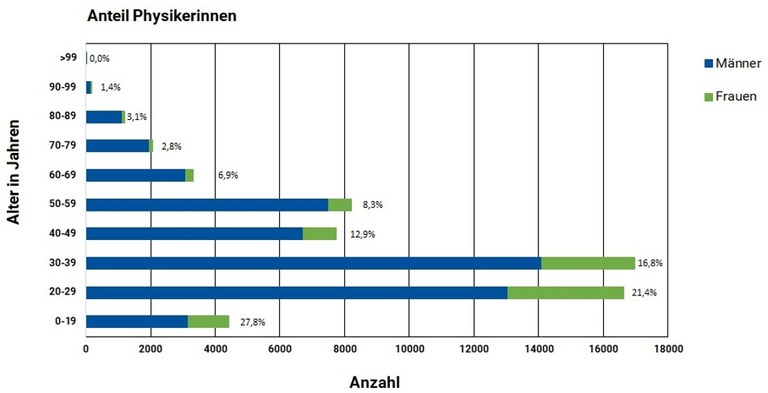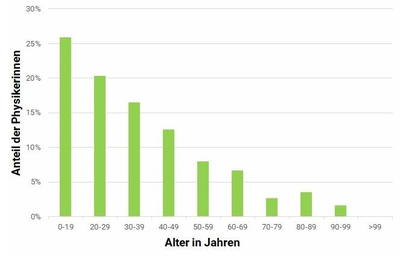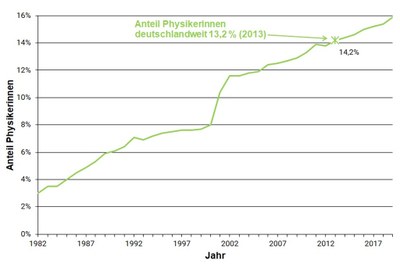2019
Mitgliederstruktur mit Stand vom 08.01.2019
Die DPG hat insgesamt 60.547 Mitglieder (Stand: 08.01.2019). Bei 137 Mitgliedern handelt es sich um Korporative Mitglieder (Institute, Bibliotheken, Schulen, Firmen). Die übrigen Mitglieder (99,8%) sind Persönliche Mitglieder, die sich folgendermaßen aufgliedern:
22,5 % Studierende
29,5 % Doktorand/inn/en, Assistent/inn/en
4,7 % Hochschullehrer/innen
12,0 % Industriephysiker/innen
8,4 % Physiker/innen im Bereich der außeruniversitären Forschung (HGF, MPG, WGL, FhG, PTB, u. a.)
4,1 % Lehrer/innen und Studierende Lehramt
0,9 % Physiker/innen im Bereich der Wissenschaftsorganisationen und -verwaltung
5,5 % Physiker/innen in sonstigen Bereichen wie Selbstständige u.a.
13,9 % Mitglieder aus Werbeaktionen
Von den Persönlichen Mitgliedern wohnen 6,3 % im Ausland. Der Frauenanteil beträgt 15,9 % (1980: 2,8 %). Der Median des Alters der Mitglieder liegt bei 34 Jahren, der Mittelwert bei 37,5 Jahren.
Altersstruktur der DPG

Die Grafik zeigt die Mitgliederstruktur der DPG nach Alterskohorten aufgeschlüsselt, wobei die Kohorten 0-9 und 10-19 Jahre aufgrund der relativ geringen Mitgliederzahl der unter 10-jährigen zusammengefasst wurde. Blau ist der Anteil der Männer, grün steht für den Anteil der Frauen in der DPG. Der größte Teil der DPG-Mitglieder ist unter 40 Jahre alt. Hier liegt der Anteil der Physikerinnen deutlich über dem Gesamtanteil weiblicher Mitglieder in der DPG.
Anteil der Physikerinnen in der DPG pro Kohorte

Die Grafik zeigt den Anteil der weiblichen DPG-Mitglieder nach Alterskohorten aufgeschlüsselt, wobei die Kohorten 0-9 und 10-19 Jahre aufgrund der relativ geringen Mitgliederzahl der unter 10-jährigen zusammengefasst wurde. Der Anteil der Physikerinnen nimmt mit steigendem Alter erwartungsgemäß ab. Bei den unter 20-jährigen liegt der Anteil bei über 25 Prozent und somit etwas höher als der Anteil der Studienanfängerinnen in der Physik generell.
Änderung des Anteils der weiblichen Mitglieder in der DPG

Die Grafik zeigt die Entwicklung des Anteils der Physikerinnen in der DPG in Prozent über die Jahre seit 1982. Während sich der Anteil der weiblichen Mitglieder in der DPG in den 1980er Jahre noch im Bereich weniger Prozent bewegte, liegt dieser nun dank eines stetigen Wachstums bei über 15 Prozent. Der sprunghafte Anstieg von mehr als zwei Prozentpunkte vom Jahr 2000 nach 2001 korreliert mit der Einführung des DPG-Abiturpreisprogramms. Im Jahr 2013 lag der Anteil der Physikerinnen in der DPG erstmals über dem Anteil der Physikerinnen deutschlandweit (lt. Mikrozensus).